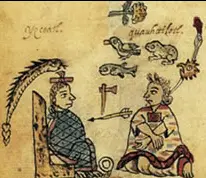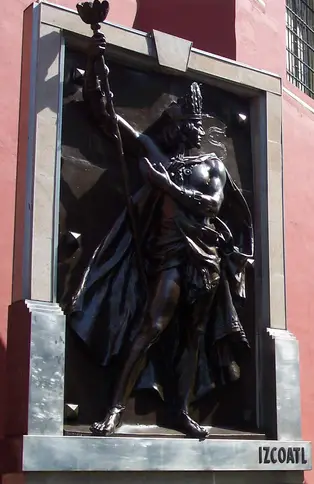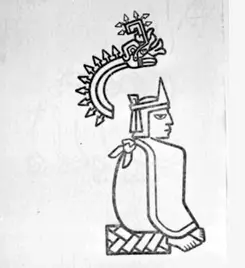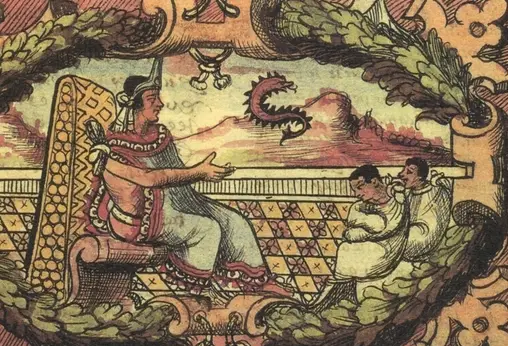Podcast: Play in new window | Download
Subscribe: Apple Podcasts | RSS
 Itzcoatl, often heralded as the first true emperor of the Aztec Empire, played a pivotal role in transforming the Mexica city-state of Tenochtitlan into the heart of a growing empire. His reign, spanning from 1427 to 1440, marked a period of significant political, social, and military transformation. In this episode of Mexico Unexplained we will examine the life and reign of Itzcoatl, highlighting his contributions to the establishment of the Aztec Empire, his military conquests, administrative reforms, and the cultural and religious shifts he championed.
Itzcoatl, often heralded as the first true emperor of the Aztec Empire, played a pivotal role in transforming the Mexica city-state of Tenochtitlan into the heart of a growing empire. His reign, spanning from 1427 to 1440, marked a period of significant political, social, and military transformation. In this episode of Mexico Unexplained we will examine the life and reign of Itzcoatl, highlighting his contributions to the establishment of the Aztec Empire, his military conquests, administrative reforms, and the cultural and religious shifts he championed.
Before we begin, let’s define terms. The Mexica, from whom the name Mexico is derived, originally referred to the people living in the interconnected settlements in what is now Mexico City. They were also known as the Culhua-Mexica due to their kinship alliance with the neighboring Culhua, who historians believe were the descendants of the Toltecs who dominated central Mexico for several centuries. The Mexica of Tenochtitlan were additionally called the “Tenochca,” a term linked to the name of their city, and its founding leader, Tenoch. The city’s builders are referred to by various names such as “Azteca,” “Mexica,” or “Tenochca” in many different sources, including primary sources coming out of Mexico in modern and pre-Conquest times. The name Aztec was coined by German historian and naturalist Alexander von Humboldt, combining the name of the mythical homeland of Aztlán and the Nahuatl word “tec,” meaning, “people of.” Today, the term “Aztec” is used to refer not only to the Mexica but also to the Nahuatl-speaking peoples of the Valley of Mexico and surrounding regions. So, someone who spoke Nahuatl and who lived on the fringes of the Valley of Mexico and had the same customs and religious beliefs as their brothers in Tenochtitlan were not Mexica because they were not of this very specific ethnic group. Under the umbrella term of “Aztec,” this person living on the fringes would be considered, however, “Aztec.” Was that confusing? This is why the term “Aztec” is used to describe closely associated Nahuatl-speaking peoples of central Mexico, much to the disappointment of many people who wish to claim to be direct descendants of those who forged this mighty empire. Not all Aztecs were Mexica.
Now, back to the first Aztec emperor.
 Itzcoatl, meaning “Obsidian Serpent,” in the Nahuatl language, was born around the year 1380 to Acamapichtli, the first ruler of Tenochtitlan, and an unnamed Tepanec princess. His mixed heritage positioned him uniquely within the Mexica nobility, granting him access to both Mexica and Tepanec aristocratic circles. Itzcoatl grew up during a time when the Mexica were under the dominance of the Tepanec Empire, led by the powerful city-state of Azcapotzalco.
Itzcoatl, meaning “Obsidian Serpent,” in the Nahuatl language, was born around the year 1380 to Acamapichtli, the first ruler of Tenochtitlan, and an unnamed Tepanec princess. His mixed heritage positioned him uniquely within the Mexica nobility, granting him access to both Mexica and Tepanec aristocratic circles. Itzcoatl grew up during a time when the Mexica were under the dominance of the Tepanec Empire, led by the powerful city-state of Azcapotzalco.
The rise to power of Itzcoatl began with the death of his predecessor, Chimalpopoca, who was likely assassinated under the orders of Maxtla, the Tepanec ruler. This event galvanized the Mexica people, who were eager to shake off years of Tepanec domination. Itzcoatl was elected as the fourth tlatoani – or ruler – of Tenochtitlan in 1427, under circumstances ripe for rebellion and change.
One of Itzcoatl’s most significant achievements within the first year of his reign was the formation of the Triple Alliance, a coalition between the loosely affiliated city-states of Tenochtitlan, Texcoco, and Tlacopan. This alliance was pivotal in defeating the Tepanec ruler Maxtla and dismantling the Tepanec control over the Valley of Mexico. The Triple Alliance marked the beginning of the Aztec Empire, with Tenochtitlan at its core.
The Aztec Triple Alliance first targeted Azcapotzalco, the Tepanec capital. In a series of well-coordinated military campaigns, Itzcoatl, along with his Texcoco and Tlacopan allies, besieged and eventually captured Azcapotzalco in 1428. This victory was not merely a military triumph but a major political event that reshaped the power dynamics of central Mexico. The dismantling of Tepanec power allowed the Mexica to assert their dominance and begin territorial expansion.
 Under Itzcoatl’s leadership, the Mexica embarked on numerous military campaigns, extending their influence over neighboring city-states and their dependencies. These conquests provided not only political power but also economic benefits, as newly subjugated regions were integrated into the tribute system that became the backbone of the massive Aztec economy. More on the economy later.
Under Itzcoatl’s leadership, the Mexica embarked on numerous military campaigns, extending their influence over neighboring city-states and their dependencies. These conquests provided not only political power but also economic benefits, as newly subjugated regions were integrated into the tribute system that became the backbone of the massive Aztec economy. More on the economy later.
Itzcoatl’s reign was marked by significant administrative reforms that helped solidify the newly formed empire’s structure and governance. Understanding the importance of a cohesive administrative framework, Itzcoatl reorganized the social and political hierarchies within Tenochtitlan and its territories.
One of his key reforms was the establishment of the calpulli system, which reorganized the commoners into community-based units responsible for local governance and tax collection. This system enhanced administrative efficiency and strengthened the central authority’s control over the populace.
Additionally, Itzcoatl worked closely with his chief advisor, Tlacaelel, to centralize power within the old Mexica nobility. Tlacaelel, though not a ruler himself, was instrumental in shaping the ideological and political landscape of the empire. According to some historians it was Tlacaelel who advised the emperor to wipe out all written records in the Aztec territories in attempt to rewrite Mexica history to legitimize their rule and emphasize their divine right to conquer and govern. As a result of this policy, many codices – or bark paper books – along with scrolls, animal parchments and other documents were burned. The historical loss went far beyond what the Franciscan friar Diego de Landa did to Maya written records discussed in Mexico Unexplained episode 106 https://mexicounexplained.com/chinampas-floating-gardens-of-ancient-mexico/. It seems to be a theme to burn books under autocratic regimes in order to promote official histories and policies, and the Aztecs were no exception.
 This rewriting of history served to instill a sense of pride and destiny among the Aztecs, portraying their rise to power as ordained by the gods. By manipulating historical narratives, Itzcoatl and Tlacaelel were able to foster a unified identity among the Mexica and their allies, essential for the stability and expansion of the empire. With a new take on history and their place in the world, the Aztecs had their own Manifest Destiny which gave them the right to conquer and dominate their neighbors and go far beyond them.
This rewriting of history served to instill a sense of pride and destiny among the Aztecs, portraying their rise to power as ordained by the gods. By manipulating historical narratives, Itzcoatl and Tlacaelel were able to foster a unified identity among the Mexica and their allies, essential for the stability and expansion of the empire. With a new take on history and their place in the world, the Aztecs had their own Manifest Destiny which gave them the right to conquer and dominate their neighbors and go far beyond them.
Itzcoatl’s reign also witnessed significant cultural and religious shifts that further solidified the Mexica’s ideological foundation. Recognizing the importance of religion in legitimizing political power, Itzcoatl promoted the worship of Huitzilopochtli, the old Mexica god of war and the sun, as the supreme deity. This emphasis on Huitzilopochtli was used to justify the empire’s militaristic expansion and the subjugation of other peoples. Other gods were allowed to be worshiped across the Aztec Empire, and many gods from conquered people were incorporated into the Aztec pantheon for social or political reasons. Despite Itzcoatl’s intense promotion of the Aztec war god, he allowed religious freedom to flourish throughout his realms.
Religious ceremonies and rituals, particularly human sacrifice, were always important to the Mexica’s religious practices. These rituals were believed to ensure the continuation of the cosmos and appease the gods. Itzcoatl’s promotion of these practices served to reinforce the divine mandate of the Mexica rulers and their conquests. The Templo Mayor in Tenochtitlan, dedicated to Huitzilopochtli and Tlaloc, the rain god, became a central site for these religious activities, symbolizing the Mexica’s spiritual and political power.
Moreover, Itzcoatl and Tlacaelel introduced the concept of the “Flowery War,” a form of ritualized conflict aimed at capturing prisoners for sacrifice rather than territorial gain. These wars served both religious and political purposes, maintaining a steady supply of sacrificial victims to appease the gods and asserting military dominance over rival states. The Tlaxcalans were some of Itzcoatl’s first enemies in this type of war, a tradition that would continue until the arrival of the Spanish almost a century later.
Economically, Itzcoatl’s reign was characterized by the establishment and expansion of a tribute or taxation system that became the economic backbone of the Aztec Empire. Conquered city-states were required to pay tribute in the form of goods, services, and labor, which were then redistributed within the empire. This system ensured a continuous flow of resources into Tenochtitlan, facilitating its growth and prosperity.
Tribute items included foodstuffs, textiles, precious metals, and luxury goods, which not only supported the old Mexica elite but also reinforced the social hierarchy. The tribute system was meticulously organized, with specific amounts and types of tribute required from each subject city-state. Failure to comply with these demands often resulted in severe punitive expeditions, reinforcing the Mexica’s dominance and control. Many of the tax documents and accounting ledgers associated with this tribute system still survive to this day.
Additionally, Itzcoatl promoted agricultural innovation and infrastructure development to support the growing population of Tenochtitlan. As discussed in Mexico Unexplained Episode 191 https://mexicounexplained.com/great-maya-book-burning/ , the construction of large chinampas, or so-called “floating gardens,” in the shallow lake beds around the city significantly increased agricultural productivity. These floating gardens allowed for the cultivation of various crops throughout the year, which included new fruit and vegetable varieties found throughout the Aztec Empire. These innovations ensured food security and variety and supported the capital city’s expanding population.
Itzcoatl’s reign laid the foundational structures that enabled the Aztec Empire to flourish long after his death. The formation of the Triple Alliance and Itzcoatl’s military conquests set the stage for the expansive empire that his successors would continue to build upon. The administrative, economic, and religious reforms he implemented created a cohesive and centralized state capable of sustaining large-scale governance and expansion.
Furthermore, the ideological shift orchestrated by Itzcoatl and Tlacaelel, through the manipulation of history and the promotion of a divine mandate, instilled a sense of purpose and identity among the Mexica. This ideological framework not only legitimized their rule but also motivated further conquests and the consolidation of power.
Itzcoatl’s impact extended beyond his immediate successors, influencing the governance and policies of future rulers such as Moctezuma the First and Ahuitzotl. The structures and systems he put in place, from the tribute system to religious practices, remained integral to the functioning and stability of the Aztec Empire until its fall to the Spanish in the early 16th century.
Itzcoatl’s reign was a transformative period in the history of the Mexica people, marking the transition from a subordinate city-state to the center of a powerful and expansive empire. Through military conquests, strategic alliances, and comprehensive reforms, Itzcoatl laid the groundwork for the Aztec Empire’s future growth and prosperity. His legacy is reflected in the enduring structures, systems, and ideologies that defined the Aztec civilization, shaping its history and influencing the broader Mesoamerican world. As the architect of the Aztec Empire, Itzcoatl’s contributions to the political, social, and cultural fabric of his time underscore his significance as a pivotal figure in the annals of pre-Columbian history.
REFERENCES
Hassig, Ross. Aztec Warfare: Imperial Expansion and Political Control. Norman: University of Oklahoma Press, 1988. Buy the book on Amazon here: https://amzn.to/3yUgGmI
Smith, Michael E. The Aztecs. 3rd ed. Malden, MA: Blackwell Publishing, 2012. Purchase the book here: https://amzn.to/3RiuYE5
Townsend, Richard F. The Aztecs. 2nd ed. London: Thames & Hudson, 2009. Purchase the book here: https://amzn.to/3KAMWOs
